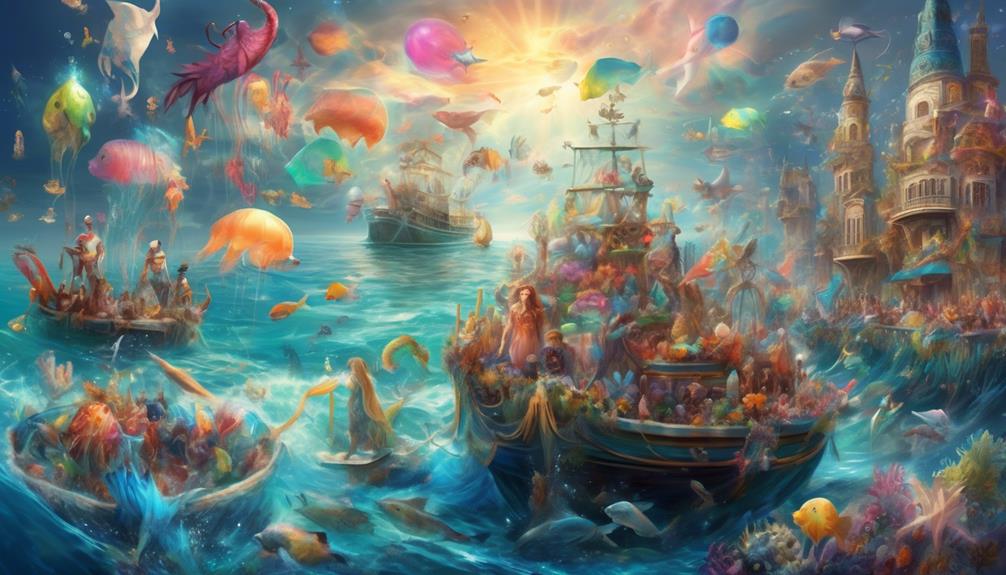Festive sea parades, while a delightful display of maritime merriment, may pose a perilous plight for ocean life. As the glittering floats and lively music draw crowds to the shores, the impact on marine ecosystems often goes unnoticed.
However, there is a growing concern among environmentalists about the potential harm caused by these parades to the delicate balance of underwater habitats. The need to address this issue is pressing, and solutions must be sought to ensure that the joyous celebrations do not come at the expense of the ocean's well-being.
Key Takeaways
- Sea parades can have negative impacts on marine life, including noise pollution, disruption of migration patterns, and habitat destruction.
- Implementing eco-friendly practices at mermaid festivals can help reduce the ecological footprint and raise awareness about sustainable choices.
- Sustainable sea parade activities involve using environmentally friendly materials, promoting recycling, and minimizing waste.
- Educating participants about ocean conservation and supporting marine life protection initiatives are crucial for preserving ocean biodiversity and fostering a sense of responsibility towards marine conservation.
Understanding the Impact of Sea Parades on Marine Life
Sea parades can significantly impact marine life, leading to disruptions in their natural behaviors and habitats. One of the key ways in which sea parades affect marine life is through noise pollution. The loud noises generated by boat engines, fireworks, and other festivities can have detrimental effects on marine animals. For example, the sharp sounds can cause stress, disorientation, and even physical harm to sensitive marine species such as whales, dolphins, and fish. This disturbance can lead to changes in their migration patterns, communication, feeding, and reproduction.
Furthermore, marine habitat disruption is another significant consequence of sea parades. The loud noises can interfere with the balance of ecosystems, causing marine organisms to abandon their natural habitats or disrupting critical behaviors such as spawning and feeding. Additionally, the physical presence of large vessels during sea parades can lead to habitat destruction, including damage to coral reefs, seagrass beds, and other essential marine environments.
Understanding these impacts is crucial for implementing measures to mitigate the effects of sea parades on marine life and ensuring the conservation of our ocean ecosystems.
Implementing Eco-friendly Practices at Mermaid Festivals
To promote environmental conservation and minimize the impact on marine life, eco-friendly practices are being implemented at mermaid festivals.
One significant focus is on reducing waste, particularly in the form of single-use plastics. Event organizers are encouraging the use of reusable and biodegradable materials for decorations, food packaging, and beverage containers.
Additionally, there's a growing emphasis on eco-conscious fashion in costumes. Designers and participants are incorporating sustainable fabrics, such as organic cotton and recycled materials, into their elaborate mermaid attire.
By prioritizing eco-friendly practices, mermaid festivals aim to set an example of responsible event management and inspire attendees to consider their environmental impact.
These initiatives not only contribute to reducing the immediate ecological footprint of the festivals but also serve as educational opportunities, raising awareness about the importance of sustainable choices in everyday life.
As mermaid festivals continue to evolve, the integration of eco-friendly practices underscores a commitment to environmental stewardship and the protection of ocean ecosystems.
Promoting Sustainable Sea Parade Activities
Promoters of sustainable sea parade activities prioritize the use of environmentally friendly materials and practices to minimize the impact on marine ecosystems. One key aspect of promoting sustainable sea parade activities is the use of eco-friendly floats. These floats are constructed using biodegradable materials and non-toxic paints to ensure that no harmful substances are released into the water.
Sustainable event planning is another crucial component, involving measures such as minimizing waste generation, promoting recycling, and reducing energy consumption during the event. Additionally, organizers can encourage the use of alternative transportation methods to reduce carbon emissions associated with travel to and from the parade.
By incorporating these sustainable practices, sea parade activities can significantly reduce their environmental footprint while still providing an enjoyable experience for participants and spectators.
Furthermore, promoting sustainable sea parade activities fosters a culture of environmental responsibility and conservation, setting a positive example for future events and encouraging broader community engagement in protecting the marine environment.
Educating Participants About Ocean Conservation
Participants in sea parades can be effectively educated about ocean conservation through interactive exhibits and engaging workshops focused on marine biodiversity and ecosystem protection. These educational initiatives play a crucial role in raising awareness about the detrimental effects of plastic pollution on marine life and the importance of sustainable tourism practices.
Interactive exhibits can showcase the impact of plastic pollution on ocean ecosystems, illustrating how it endangers marine species and disrupts the delicate balance of aquatic environments. Engaging workshops can delve into the concept of sustainable tourism, emphasizing the significance of responsible travel and its positive effects on ocean conservation.
By educating participants about these critical issues, sea parades can inspire a sense of environmental stewardship and encourage proactive efforts to safeguard the oceans. Furthermore, these educational opportunities provide a platform for sharing practical conservation tips, empowering participants to take meaningful actions in their daily lives to protect the marine environment.
Supporting Marine Life Protection Initiatives
How can sea parades actively contribute to the protection of marine life through the support of conservation initiatives and research efforts?
Sea parades can play a crucial role in supporting marine life protection initiatives and advancing ocean biodiversity. These events provide an excellent platform to raise awareness about marine conservation and promote the importance of preserving ocean biodiversity.
Sea parades can collaborate with marine conservation organizations to raise funds for conservation initiatives, such as the establishment of marine protected areas, research expeditions, and the development of sustainable fishing practices. By actively involving the participants and spectators in these initiatives, sea parades can foster a sense of responsibility towards marine conservation and encourage individuals to contribute to the protection of ocean biodiversity.
Additionally, sea parades can serve as a means to showcase ongoing research efforts and conservation projects, thereby educating the public about the significance of these initiatives in safeguarding marine life. Through these collaborative efforts, sea parades can significantly contribute to supporting marine life protection initiatives and promoting the conservation of ocean biodiversity.
Frequently Asked Questions
What Are the Specific Regulations and Guidelines for Sea Parades to Ensure the Safety and Protection of Marine Life?
Regulatory compliance is vital to protect marine life during sea parades. Guidelines include speed limits, noise restrictions, and designated routes to reduce disturbance. Environmental education raises awareness of the importance of ocean conservation and the impact of parades on marine ecosystems.
How Can Local Communities and Businesses Contribute to Reducing the Environmental Impact of Sea Parades on Ocean Life?
Local communities and businesses can reduce the environmental impact of sea parades on ocean life through community engagement, adopting sustainable practices, supporting marine conservation initiatives, and forming partnerships with businesses to promote responsible environmental stewardship.
Are There Any Alternative Materials or Methods That Can Be Used in Sea Parade Activities to Minimize Harm to Marine Life?
Alternative materials and eco-friendly decorations are vital in minimizing harm to marine life during sea parades. Biodegradable floats and sustainable parade practices can significantly reduce the environmental impact of these events, promoting ocean conservation efforts.
What Are Some Long-Term Goals for Promoting Ocean Conservation and Protecting Marine Life Within the Context of Sea Parades?
Long term goals for marine conservation involve community involvement and promoting sustainable practices. This approach aims to protect marine life not only during sea parades but also in the long run, ensuring the health of our oceans.
What Are Some Examples of Successful Marine Life Protection Initiatives That Have Been Supported by Sea Parade Organizers and Participants?
Successful marine conservation initiatives supported by sea parade organizers and participants include beach cleanups, sustainable seafood promotion, and educational outreach on marine life protection. Community engagement is crucial for the long-term success of these efforts.

